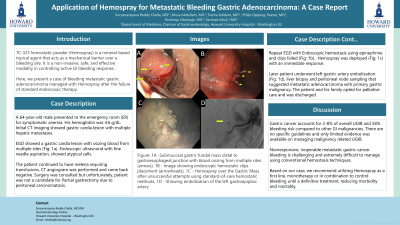Back


Poster Session A - Sunday Afternoon
Category: GI Bleeding
A0316 - Application of Hemospray for Metastatic Bleeding Gastric Adenocarcinoma: A Case Report
Sunday, October 23, 2022
5:00 PM – 7:00 PM ET
Location: Crown Ballroom

Has Audio

Suryanarayana Reddy Challa, MD
Howard University Hospital
Washington, DC
Presenting Author(s)
Suryanarayana Reddy Challa, MD1, Abdullahi Musa, MD2, Sneha Adidam, MD1, Philip Oppong-Twene, MD1, Temitayo Gboluaje, MD, MBA1, Farshad Aduli, MD1
1Howard University Hospital, Washington, DC; 2Howard University Hospital, Arlington, VA
Introduction: TC-325 hemostatic powder (Hemospray) is a mineral-based topical agent that acts as a mechanical barrier over a bleeding site. It is a non-invasive, safe, and effective modality in controlling active GI bleeding, with immediate response. Here, we present a case of bleeding metastatic gastric adenocarcinoma managed with Hemospray after the failure of standard endoscopic therapy.
Case Description/Methods: A 64-year-old male presented to the emergency room (ER) for symptomatic anemia. His hemoglobin was 4.6 g/dL. CT imaging showed gastric cardia lesion with multiple hepatic metastases. After blood transfusion, EGD (Fig: 1a) showed a cardia lesion with oozing blood from multiple sites. Endoscopic ultrasound with fine-needle aspiration, showing atypical cells. The patient continued to have melena requiring transfusions. CT angiogram was negative. Partial gastrectomy was not performed due to peritoneal carcinomatosis. Endoscopic hemostasis with epinephrine and clips failed (Fig: 1b). Hemospray was deployed (Fig: 1c) with an immediate response. Later patient underwent left gastric artery embolization (Fig: 1d), liver biopsy and peritoneal node sampling that suggested metastatic adenocarcinoma with primary gastric malignancy. The patient and his family opted for palliative care and was discharged.
Discussion: Gastric cancer accounts for 2-8% of overall UGIB and 58% bleeding risk compared to other GI malignancies. There are no specific guidelines and only limited evidence was available on managing malignancy-related UGIB. Nonresponsive, inoperable metastatic gastric cancer bleeding is challenging and extremely difficult to manage using conventional hemostasis techniques. Based on our case, we recommend utilizing Hemospray as a first-line, monotherapy or in combination to control bleeding until a definitive treatment, reducing morbidity and mortality.

Disclosures:
Suryanarayana Reddy Challa, MD1, Abdullahi Musa, MD2, Sneha Adidam, MD1, Philip Oppong-Twene, MD1, Temitayo Gboluaje, MD, MBA1, Farshad Aduli, MD1. A0316 - Application of Hemospray for Metastatic Bleeding Gastric Adenocarcinoma: A Case Report, ACG 2022 Annual Scientific Meeting Abstracts. Charlotte, NC: American College of Gastroenterology.
1Howard University Hospital, Washington, DC; 2Howard University Hospital, Arlington, VA
Introduction: TC-325 hemostatic powder (Hemospray) is a mineral-based topical agent that acts as a mechanical barrier over a bleeding site. It is a non-invasive, safe, and effective modality in controlling active GI bleeding, with immediate response. Here, we present a case of bleeding metastatic gastric adenocarcinoma managed with Hemospray after the failure of standard endoscopic therapy.
Case Description/Methods: A 64-year-old male presented to the emergency room (ER) for symptomatic anemia. His hemoglobin was 4.6 g/dL. CT imaging showed gastric cardia lesion with multiple hepatic metastases. After blood transfusion, EGD (Fig: 1a) showed a cardia lesion with oozing blood from multiple sites. Endoscopic ultrasound with fine-needle aspiration, showing atypical cells. The patient continued to have melena requiring transfusions. CT angiogram was negative. Partial gastrectomy was not performed due to peritoneal carcinomatosis. Endoscopic hemostasis with epinephrine and clips failed (Fig: 1b). Hemospray was deployed (Fig: 1c) with an immediate response. Later patient underwent left gastric artery embolization (Fig: 1d), liver biopsy and peritoneal node sampling that suggested metastatic adenocarcinoma with primary gastric malignancy. The patient and his family opted for palliative care and was discharged.
Discussion: Gastric cancer accounts for 2-8% of overall UGIB and 58% bleeding risk compared to other GI malignancies. There are no specific guidelines and only limited evidence was available on managing malignancy-related UGIB. Nonresponsive, inoperable metastatic gastric cancer bleeding is challenging and extremely difficult to manage using conventional hemostasis techniques. Based on our case, we recommend utilizing Hemospray as a first-line, monotherapy or in combination to control bleeding until a definitive treatment, reducing morbidity and mortality.

Figure: FIgure: 1A -Submucosal gastric fundal mass distal to gastroesophageal junction with blood oozing from multiple sites (arrows), 1B - Image showing endoscopic hemostatic clips placement (arrowheads), 1C - Application of Hemospray over the Gastric Mass after unsuccessful attempts using standard-of-care hemostatic methods, 1D - Showing embolization of the left gastroepiploic artery
Disclosures:
Suryanarayana Reddy Challa indicated no relevant financial relationships.
Abdullahi Musa indicated no relevant financial relationships.
Sneha Adidam indicated no relevant financial relationships.
Philip Oppong-Twene indicated no relevant financial relationships.
Temitayo Gboluaje indicated no relevant financial relationships.
Farshad Aduli indicated no relevant financial relationships.
Suryanarayana Reddy Challa, MD1, Abdullahi Musa, MD2, Sneha Adidam, MD1, Philip Oppong-Twene, MD1, Temitayo Gboluaje, MD, MBA1, Farshad Aduli, MD1. A0316 - Application of Hemospray for Metastatic Bleeding Gastric Adenocarcinoma: A Case Report, ACG 2022 Annual Scientific Meeting Abstracts. Charlotte, NC: American College of Gastroenterology.
